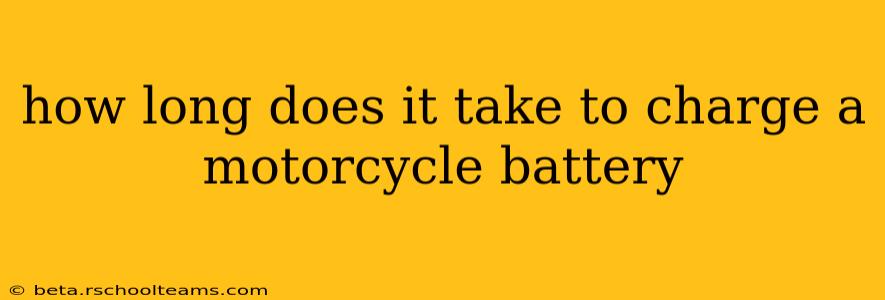How Long Does It Take to Charge a Motorcycle Battery?
Charging a motorcycle battery depends on several factors, making it impossible to give a single definitive answer. The charging time varies greatly depending on the battery's capacity (measured in Amp-hours or Ah), its state of discharge, the type of charger used, and even the ambient temperature. Let's break down these key influences to give you a better understanding.
What Factors Affect Motorcycle Battery Charging Time?
-
Battery Capacity (Ah): A larger capacity battery (e.g., 12Ah) will naturally take longer to charge than a smaller one (e.g., 7Ah). The higher the Ah rating, the more charge it can hold, and consequently, the longer it takes to fill.
-
State of Discharge (SoD): A completely dead battery will require significantly more charging time than one that's only partially discharged. If the battery is deeply discharged (below 50%), it might need several hours, or even overnight charging. A battery that's only slightly discharged could charge in a much shorter period.
-
Charger Type and Amperage: Different chargers have different output currents (measured in Amperes or Amps). A higher amperage charger will charge the battery faster, but using too high an amperage can damage the battery. Always check your battery's specifications and use a charger appropriate for its type and capacity. Trickle chargers deliver a low amperage and are suitable for long, slow charging, minimizing the risk of overheating. Faster chargers are more efficient for quicker charging but need careful monitoring.
-
Ambient Temperature: Extreme temperatures (both hot and cold) can affect the charging process. Cold temperatures can slow down the chemical reactions within the battery, extending the charging time. Conversely, excessive heat can damage the battery and also affect charging efficiency. Ideally, charge your battery in a moderate temperature environment.
How Long Does it Typically Take?
While precise times are difficult to predict, here's a general guideline:
-
Trickle Charger: Expect 12-24 hours, or even longer for a deeply discharged battery. This method is safe but slow.
-
Standard Charger (1-2 Amps): A few hours for a partially discharged battery, up to 8-10 hours for a fully depleted one. This is a good balance between speed and safety.
-
Fast Charger (Higher Amperage): Potentially as little as 1-3 hours depending on the battery capacity and charger amperage. However, using a fast charger requires more attention to prevent overcharging and potential damage.
What Happens if I Overcharge My Motorcycle Battery?
Overcharging can lead to significant damage to your motorcycle battery, including:
- Reduced lifespan: Excessive charging can generate excessive heat, leading to premature aging and shorter battery life.
- Electrolyte loss: Overcharging can cause the electrolyte to evaporate, reducing the battery's capacity and potentially causing it to fail.
- Battery damage: In severe cases, overcharging can permanently damage the battery, rendering it unusable.
How Can I Avoid Overcharging?
-
Use a charger with an automatic shutoff feature: Many modern chargers include a system to automatically stop charging once the battery is full. This eliminates the risk of overcharging.
-
Monitor the charging process: Regularly check the battery's voltage and temperature during charging to avoid potential problems.
-
Follow the charger's instructions: Always follow the manufacturer's instructions for both the charger and the battery.
In conclusion, the charging time for a motorcycle battery isn't fixed. Understanding the factors that influence charging time, using the right charger, and monitoring the process are vital to ensuring your battery's health and longevity. Always consult your battery and charger manuals for specific recommendations.
